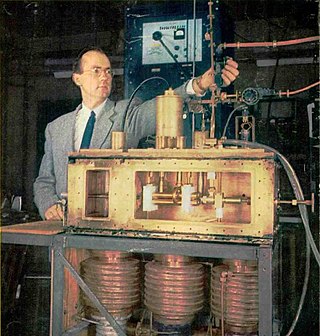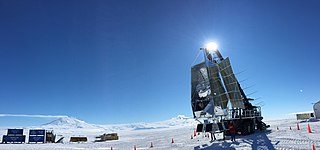
A maser is a device that produces coherent electromagnetic waves (microwaves),through amplification by stimulated emission. The term is an acronym for microwave amplification by stimulated emission of radiation. Nikolay Basov,Alexander Prokhorov and Joseph Weber introduced the concept of the maser in 1952,and Charles H. Townes,James P. Gordon,and Herbert J. Zeiger built the first maser at Columbia University in 1953. Townes,Basov and Prokhorov won the 1964 Nobel Prize in Physics for theoretical work leading to the maser. Masers are used as timekeeping devices in atomic clocks,and as extremely low-noise microwave amplifiers in radio telescopes and deep-space spacecraft communication ground-stations.

Microwave is a form of electromagnetic radiation with wavelengths shorter than other radio waves but longer than infrared waves. Its wavelength ranges from about one meter to one millimeter,corresponding to frequencies between 300 MHz and 300 GHz,broadly construed. A more common definition in radio-frequency engineering is the range between 1 and 100 GHz,or between 1 and 3000 GHz . The prefix micro- in microwave is not meant to suggest a wavelength in the micrometer range;rather,it indicates that microwaves are small,compared to the radio waves used in prior radio technology.
Cosmic noise,also known as galactic radio noise,is a physical phenomenon derived from outside of the Earth's atmosphere. It is not actually sound,and it can be detected through a radio receiver,which is an electronic device that receives radio waves and converts the information given by them to an audible form. Its characteristics are comparable to those of thermal noise. Cosmic noise occurs at frequencies above about 15 MHz when highly directional antennas are pointed toward the Sun or other regions of the sky,such as the center of the Milky Way Galaxy. Celestial objects like quasars,which are super dense objects far from Earth,emit electromagnetic waves in their full spectrum,including radio waves. The fall of a meteorite can also be heard through a radio receiver;the falling object burns from friction with the Earth's atmosphere,ionizing surrounding gases and producing radio waves. Cosmic microwave background radiation (CMBR) from outer space is also a form of cosmic noise. CMBR is thought to be a relic of the Big Bang,and pervades the space almost homogeneously over the entire celestial sphere. The bandwidth of the CMBR is wide,though the peak is in the microwave range.

A radio telescope is a specialized antenna and radio receiver used to detect radio waves from astronomical radio sources in the sky. Radio telescopes are the main observing instrument used in radio astronomy,which studies the radio frequency portion of the electromagnetic spectrum emitted by astronomical objects,just as optical telescopes are the main observing instrument used in traditional optical astronomy which studies the light wave portion of the spectrum coming from astronomical objects. Unlike optical telescopes,radio telescopes can be used in the daytime as well as at night.

Radio astronomy is a subfield of astronomy that studies celestial objects at radio frequencies. The first detection of radio waves from an astronomical object was in 1933,when Karl Jansky at Bell Telephone Laboratories reported radiation coming from the Milky Way. Subsequent observations have identified a number of different sources of radio emission. These include stars and galaxies,as well as entirely new classes of objects,such as radio galaxies,quasars,pulsars,and masers. The discovery of the cosmic microwave background radiation,regarded as evidence for the Big Bang theory,was made through radio astronomy.

Radio waves are a type of electromagnetic radiation with the lowest frequencies and the longest wavelengths in the electromagnetic spectrum,typically with frequencies below 300 gigahertz (GHz) and wavelengths greater than 1 millimeter,about the diameter of a grain of rice. Radio waves with frequencies above about 1 GHz and wavelengths shorter than 30 centimeters are called microwaves. Like all electromagnetic waves,radio waves in vacuum travel at the speed of light,and in the Earth's atmosphere at a slightly lower speed. Radio waves are generated by charged particles undergoing acceleration,such as time-varying electric currents. Naturally occurring radio waves are emitted by lightning and astronomical objects,and are part of the blackbody radiation emitted by all warm objects.

A parabolic antenna is an antenna that uses a parabolic reflector,a curved surface with the cross-sectional shape of a parabola,to direct the radio waves. The most common form is shaped like a dish and is popularly called a dish antenna or parabolic dish. The main advantage of a parabolic antenna is that it has high directivity. It functions similarly to a searchlight or flashlight reflector to direct radio waves in a narrow beam,or receive radio waves from one particular direction only. Parabolic antennas have some of the highest gains,meaning that they can produce the narrowest beamwidths,of any antenna type. In order to achieve narrow beamwidths,the parabolic reflector must be much larger than the wavelength of the radio waves used,so parabolic antennas are used in the high frequency part of the radio spectrum,at UHF and microwave (SHF) frequencies,at which the wavelengths are small enough that conveniently sized reflectors can be used.

A directional antenna or beam antenna is an antenna which radiates or receives greater radio wave power in specific directions. Directional antennas can radiate radio waves in beams,when greater concentration of radiation in a certain direction is desired,or in receiving antennas receive radio waves from one specific direction only. This can increase the power transmitted to receivers in that direction,or reduce interference from unwanted sources. This contrasts with omnidirectional antennas such as dipole antennas which radiate radio waves over a wide angle,or receive from a wide angle.

The hydrogen line,21 centimeter line,or H I line is a spectral line that is created by a change in the energy state of solitary,electrically neutral hydrogen atoms. It is produced by a spin-flip transition,which means the direction of the electron's spin is reversed relative to the spin of the proton. This is a quantum state change between the two hyperfine levels of the hydrogen 1 s ground state. The electromagnetic radiation producing this line has a frequency of 1420.405751768(2) MHz (1.42 GHz),which is equivalent to a wavelength of 21.106114054160(30) cm in a vacuum. According to the Planck–Einstein relation E = hν,the photon emitted by this transition has an energy of 5.8743261841116(81) μeV [9.411708152678(13)×10−25 J]. The constant of proportionality,h,is known as the Planck constant.

The Large Millimeter Telescope (LMT),officially the Large Millimeter Telescope Alfonso Serrano,is the world's largest single-aperture telescope in its frequency range,built for observing radio waves in the wave lengths from approximately 0.85 to 4 mm. It has an active surface with a diameter of 50 metres (160 ft) and 1,960 square metres (21,100 sq ft) of collecting area.

A horn antenna or microwave horn is an antenna that consists of a flaring metal waveguide shaped like a horn to direct radio waves in a beam. Horns are widely used as antennas at UHF and microwave frequencies,above 300 MHz. They are used as feed antennas for larger antenna structures such as parabolic antennas,as standard calibration antennas to measure the gain of other antennas,and as directive antennas for such devices as radar guns,automatic door openers,and microwave radiometers. Their advantages are moderate directivity,broad bandwidth,low losses,and simple construction and adjustment.

Submillimetre astronomy or submillimeter astronomy is the branch of observational astronomy that is conducted at submillimetre wavelengths of the electromagnetic spectrum. Astronomers place the submillimetre waveband between the far-infrared and microwave wavebands,typically taken to be between a few hundred micrometres and a millimetre. It is still common in submillimetre astronomy to quote wavelengths in 'microns',the old name for micrometre.
In astronomy,spinning dust emission is a mechanism proposed to explain anomalous microwave emission from the Milky Way. The emission could arise from the electric dipole of very rapidly spinning (10–60 GHz) extremely small (nanometer) dust grains as suggested by Bruce T. Draine and Alex Lazarian in 1998,most likely polycyclic aromatic hydrocarbons. The anomalous emission was first discovered as a by-product of Cosmic Microwave Background observations which make very sensitive measurements of the microwave sky which have to identify and remove contamination from the galaxy. The smallest dust grains are thought to have only hundreds of atoms.

Spider is a balloon-borne experiment designed to search for primordial gravitational waves imprinted on the cosmic microwave background (CMB). Measuring the strength of this signal puts limits on inflationary theory.

Submillimeter Wave Astronomy Satellite is a NASA submillimetre astronomy satellite,and is the fourth spacecraft in the Small Explorer program (SMEX). It was launched on 6 December 1998,at 00:57:54 UTC,from Vandenberg Air Force Base aboard a Pegasus XL launch vehicle. The telescope was designed by the Smithsonian Astrophysical Observatory (SAO) and integrated by Ball Aerospace,while the spacecraft was built by NASA's Goddard Space Flight Center (GSFC). The mission's principal investigator is Gary J. Melnick.

Pierre Kauffman Radio Observatory,formerly known as the Itapetinga Radio Observatory,is a radio observatory located in the municipality of Atibaia in the state of São Paulo in Brazil. It is located approximately 7.5 km (4.7 mi) south of Atibaia and 40 km (25 mi) north of São Paulo. ROI was founded in 1970 by Universidade Presbiteriana Mackenzie (UPM). Control of the facility was passed to the National Institute for Space Research (INPE) in 1982. Today it is managed jointly by INPE,UPM,University do Vale do Paraíba (Univap),Universidade de São Paulo (USP),and Universidade Federal de Itajubá(UNIFEI). In addition to the telescopes,the observatory has living quarters for visiting scientists. ROI is located inside a small radio quiet zone. It was renamed in 2016 after Pierre Kauffman.

The Large Latin American Millimeter Array (LLAMA) is a single-dish 12 m Nasmyth optics antenna which is under construction in the Puna de Atacama desert in the Province of Salta,Argentina,next to the Qubic experiment. The primary mirror accuracy will allow observation from 40 GHz up to 900 GHz. After installation it will be able to join other similar instruments to perform Very Large Base Line Interferometry or to work in standalone mode. Financial support is provided by the Argentinian and Brazilian governments. The total cost of construction,around US$20 million,and operation as well as the telescope time use will be shared equally by the two countries. Construction planning started in July 2014 after the formal signature of an agreement between the main institutions involved.

The POlarization Emission of Millimeter Activity at the Sun (POEMAS) is a solar patrol system composed of two radio telescopes with superheterodyne circular polarization receivers at 45 and 90 GHz. Since their half power beam width is around 1.4°,they observe the full sun. The acquisition system allows to gather 100 values per second at both frequencies and polarizations,with a sensitivity of around 20 solar flux units (SFU) (1 SFU ≡104 Jy). The telescope saw first light in November 2011,and showed excellent performance during two years,when it observed many flares. Since November 2013 is stopped for repairing. The main interest of POEMAS is the observation of solar flares in a frequency range where there are very few detectors and fill the gap between microwaves observed with the Radio Solar Telescope Network (1 to 15.4 GHz) and submillimeter observations of the Solar Submillimeter Telescope (212 and 405 GHz). Moreover,POEMAS is the only current telescope capable of carrying on circular polarization solar flare observations at 90 GHz. (Although,in principle,ALMA band 3 may also observe at 90 GHz with circular polarization).

The QUIJOTE CMB Experiment is an ongoing experiment started in November 2012,and led by Rafael Rebolo López,with the goal of characterizing the polarization of the cosmic microwave background (CMB) and other galactic and extragalactic emission in the frequency range 10 to 40 GHz,at angular scales of 1°. These measurements will complement at low frequency and correct from galactic contamination those obtained by the Planck satellite from 2009 to 2013.

BINGO is a 40 m (130 ft) transit radio telescope currently under construction that will observe redshifted hydrogen line emission by intensity mapping to measure dark energy through baryon acoustic oscillations (BAO) in the radio frequency band.


















